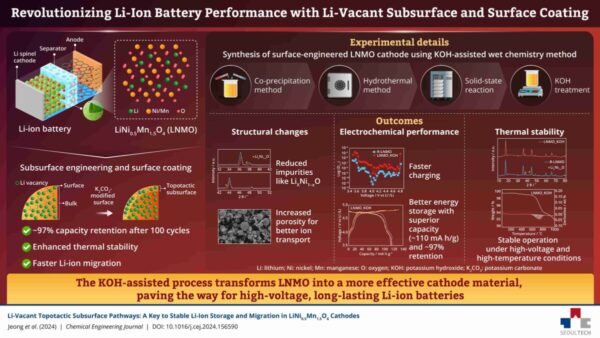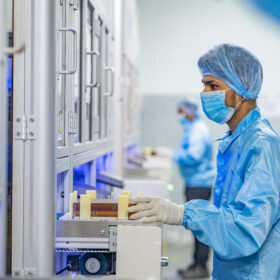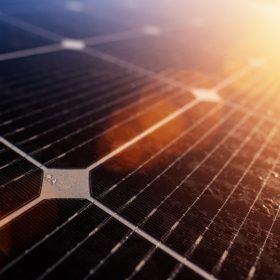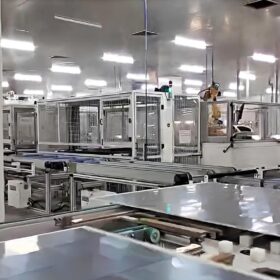Researchers at the Seoul National University of Science and Technology (Seoultech) have developed a breakthrough lithium-ion battery technology with the potential to transform electric vehicles (EVs) and energy storage systems, making them more reliable and cost-effective.
Led by Seoultech Professor Dongwook Han, researchers developed an innovative technique to enhance the high-voltage LiNi₀.₅Mn₁.₅O₄ (LNMO) cathodes.
By engineering a Li-vacant topotactic subsurface with a protective K₂CO₃ surface layer on cathode particles, they enhanced the stability, longevity and performance of Li-ion batteries.
The researchers sought to address the rise in global demand for cost-effective sustainable batteries, of which lithium-ion batteries are currently at the forefront seeing high energy density with long-term stability essential to extend the usage time of electric devices.
Though known for its thermal stability and cost-effectiveness as a promising material for high-voltage cathodes, LNMO is limited by undesirable side reactions such as electrolyte decomposition, which decreases its performance over time.
Han and his team of researchers introduced a dual engineering approach to enhance the performance of LNMO cathodes by engineering Li-vacant subsurface pathways to improve lithium-ion migration and a K₂CO₃-enriched protective layer to protect the cathode from electrolyte decomposition.
“To enhance the performance of LNMO cathodes, we introduced a K2CO3-enriched external surface and a partially delithiated subsurface of LNMO particles through a KOH-assisted wet chemistry method,” Han said.
“The synergistic effect of these layers results in a remarkable electrochemical charge/discharge cycling performance and increased thermal stability of LNMO cathodes.”

Image: Dongwook Han, Seoul National University of Science and Technology
The surface-engineered cathodes were prepared in a two-step process. First, the regular LNMO (R-LNMO) cathodes were synthesised using co-precipitation-assisted hydrothermal followed by solid-state reactions.
The prepared R-LNMO cathodes were then subjected to surface modification by treating the particles with an aqueous solution of KOH. This resulted in the formation of surface-modified LNMO, or simply LNMO_KOH.
The LNMO_KOH and R-LNMO cathode particles were tested for their physicochemical and electrochemical characteristics using advanced techniques. Researchers describe the findings as “remarkable”, suggesting enhanced thermal stability and better energy storage in the LNMO_KOH particles.
The cathodes exhibited a discharge capacity of ~110 mAh/g with 97% capacity retention after 100 cycles, a notable improvement from the 89 mAh/g discharge capacity and the 91% retention of untreated LNMO cathodes.
The engineered material also showed potential for faster charging with reduced impurities and increased porosity within its structure.
“Our technology is not limited to LNMO but can also be applied to commercial cathode materials, including high-performance Li[Ni1-y-zCoyMnz]O2 (NMC) and LiFePO4 (LFP),” Han said.
“We believe this will advance the applications of batteries in large-scale electric vehicles and energy storage systems by enabling high energy density and exceptional safety.”
Their study can be viewed in Volume 499 of the Chemical Engineering journal dated 1 November, 2024.
This content is protected by copyright and may not be reused. If you want to cooperate with us and would like to reuse some of our content, please contact: editors@pv-magazine.com.








By submitting this form you agree to pv magazine using your data for the purposes of publishing your comment.
Your personal data will only be disclosed or otherwise transmitted to third parties for the purposes of spam filtering or if this is necessary for technical maintenance of the website. Any other transfer to third parties will not take place unless this is justified on the basis of applicable data protection regulations or if pv magazine is legally obliged to do so.
You may revoke this consent at any time with effect for the future, in which case your personal data will be deleted immediately. Otherwise, your data will be deleted if pv magazine has processed your request or the purpose of data storage is fulfilled.
Further information on data privacy can be found in our Data Protection Policy.